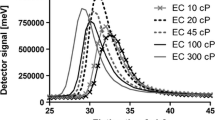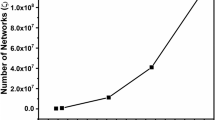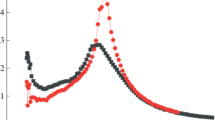Abstract
In the present paper we suggest a new concept to overcome some of the so far unsolved problems of the structure–property relationship of methylcellulose, the most important nonionic cellulose ether industrially produced in large scale. Not only from the viewpoint of scientific understanding, but also from that of the peculiar and application-determining behavior, the aggregation in aqueous solution and phase separation on heating are the most important questions. As a part of the concept, we had prepared amphiphilic block co-oligomers of tri-O-methylated and unmodified cello-oligosaccharides as structural models of typical sequences in methylcellulose chains. Now static and dynamic light scattering measurements and transmission electron microscopy (TEM) were carried out using solutions of the oligomers in water. Ellipsoidal particles with dimensions of about 50 nm for the semi-major axis and of circa 25 nm for the semi-minor one could be detected. These findings agree with the radii of gyration and the hydrodynamic radii, determined by static and dynamic light scattering. The data preliminary obtained demonstrate the strong aggregation tendency of block-like methylated cello-oligosaccharides.





Similar content being viewed by others
References
Hartmann RG, Deshmukh BK, Conklin J, Torowski M, Lynch S (2007) Determination of methylcellulose and hydroxypropyl methylcellulose food gums in food products: Collaborative study. J AOAC Int 90(3):786–793
Kamitakahara H, Nakatsubo F, Klemm D (2006) Block co-oligomers of tri-O-methylated and unmodified cello-oligosaccharides as model compounds for methylcellulose and its dissolution/gelation behavior. Cellulose 13(4):375–392. doi:10.1007/s10570-005-9003-6
Kamitakahara H, Nakatsubo F, Klemm D (2007) New class of carbohydrate-based nonionic surfactants: Diblock co-oligomers of tri-O-methylated and unmodified cello-oligosaccharides. Cellulose 14(5):513–528. doi:10.1007/s10570-007-9128-x
Kato T, Maeda H, Takahashi A (1987) Properties of cement mortars modified with water-soluble cellulose derivatives. Kobunshi Ronbunshu 44(3):179–183
Klemm D, Heublein B, Fink HP, Bohn A (2005) Cellulose: Fascinating biopolymer and sustainable raw material. Angew Chem Int Ed 44(22):3358–3393. doi:10.1002/anie.200460587
Nishinari K, Takahashi R (2003) Interaction in polysaccharide solutions and gels. Curr Opin Colloid Interface Sci 8(4–5):396–400
Savage AB (1957) Temperature-viscosity relationships for water-soluble cellulose ethers. Ind Eng Chem 49:99–103. doi:10.1021/ie50565a035
Acknowledgments
H. Kamitakahara acknowledges the Alexander von Humboldt Foundation for a research fellowship at Friedrich Schiller University of Jena. The authors are indebted to Prof. Dr. Takayoshi Matsumoto and Prof. Dr. Daisuke Tatsumi for help with the light scattering measurements. The investigation was supported in part by a Grant-in-Aid for Scientific Research from the Ministry of Education, Science, and Culture of Japan (Nos. 13760132, 15780124, 18680009).
Author information
Authors and Affiliations
Corresponding author
Rights and permissions
About this article
Cite this article
Kamitakahara, H., Yoshinaga, A., Aono, H. et al. New approach to unravel the structure–property relationship of methylcellulose. Cellulose 15, 797–801 (2008). https://doi.org/10.1007/s10570-008-9232-6
Received:
Accepted:
Published:
Issue Date:
DOI: https://doi.org/10.1007/s10570-008-9232-6




